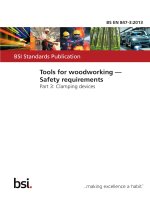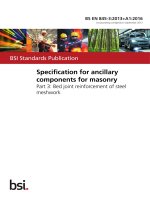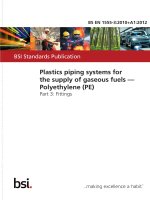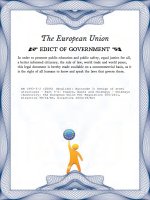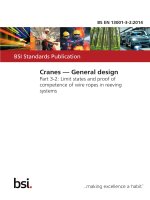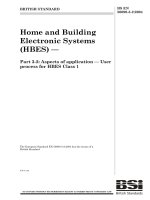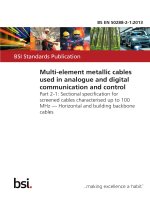Bsi bs en 50288 3 2 2013
Bạn đang xem bản rút gọn của tài liệu. Xem và tải ngay bản đầy đủ của tài liệu tại đây (956.71 KB, 20 trang )
BS EN 50288-3-2:2013
BSI Standards Publication
Multi-element metallic cables
used in analogue and digital
communication and control
Part 3-2: Sectional specification for
unscreened cables characterised up to 100
MHz — Work area and patch cord cables
BS EN 50288-3-2:2013
BRITISH STANDARD
National foreword
This British Standard is the UK implementation of EN
50288-3-2:2013. It supersedes BS EN 50288-3-2:2003 which is
withdrawn.
The UK participation in its preparation was entrusted to Technical
Committee EPL/46, Cables, wires and waveguides, radio frequency
connectors and accessories for communication and signalling.
A list of organizations represented on this committee can be
obtained on request to its secretary.
This publication does not purport to include all the necessary
provisions of a contract. Users are responsible for its correct
application.
© The British Standards Institution 2013.
Published by BSI Standards Limited 2013
ISBN 978 0 580 77097 5
ICS 33.120.20
Compliance with a British Standard cannot confer immunity from
legal obligations.
This British Standard was published under the authority of the
Standards Policy and Strategy Committee on 30 September 2013.
Amendments/corrigenda issued since publication
Date
Text affected
BS EN 50288-3-2:2013
EUROPEAN STANDARD
EN 50288-3-2
NORME EUROPÉENNE
EUROPÄISCHE NORM
May 2013
ICS 33.120.20
Supersedes EN 50288-3-2:2003
English version
Multi-element metallic cables used in analogue and digital communication
and control Part 3-2: Sectional specification for unscreened cables characterised up
to 100 MHz Work area and patch cord cables
Câbles métalliques à éléments multiples
utilisés pour les transmissions et les
commandes analogiques et numériques Partie 3-2: Spécification intermédiaire
pour les câbles non blindés pour
applications jusqu'à 100 MHz Câbles de zone de travail et de brassage
Mehradrige metallische Daten- und
Kontrollkabel für analoge und digitale
Übertragung Teil 3-2: Rahmenspezifikation für
ungeschirmte Kabel bis 100 MHz Geräteanschlusskabel und Schaltkabel
This European Standard was approved by CENELEC on 2013-03-18. CENELEC members are bound to comply
with the CEN/CENELEC Internal Regulations which stipulate the conditions for giving this European Standard
the status of a national standard without any alteration.
Up-to-date lists and bibliographical references concerning such national standards may be obtained on
application to the CEN-CENELEC Management Centre or to any CENELEC member.
This European Standard exists in three official versions (English, French, German). A version in any other
language made by translation under the responsibility of a CENELEC member into its own language and notified
to the CEN-CENELEC Management Centre has the same status as the official versions.
CENELEC members are the national electrotechnical committees of Austria, Belgium, Bulgaria, Croatia, Cyprus,
the Czech Republic, Denmark, Estonia, Finland, Former Yugoslav Republic of Macedonia, France, Germany,
Greece, Hungary, Iceland, Ireland, Italy, Latvia, Lithuania, Luxembourg, Malta, the Netherlands, Norway, Poland,
Portugal, Romania, Slovakia, Slovenia, Spain, Sweden, Switzerland, Turkey and the United Kingdom.
CENELEC
European Committee for Electrotechnical Standardization
Comité Européen de Normalisation Electrotechnique
Europäisches Komitee für Elektrotechnische Normung
Management Centre: Avenue Marnix 17, B - 1000 Brussels
© 2013 CENELEC -
All rights of exploitation in any form and by any means reserved worldwide for CENELEC members.
Ref. No. EN 50288-3-2:2013 E
BS EN 50288-3-2:2013
EN 50288-3-2:2013
-2-
Contents
Page
Foreword ................................................................................................................................ 3
1 Scope .................................................................................................................................. 4
2 Normative references ........................................................................................................... 4
3 Terms, definitions, symbols and abbreviations ...................................................................... 4
3.1 Terms and definitions .................................................................................................. 4
3.2 Symbols and abbreviations .......................................................................................... 4
4 Cable construction ............................................................................................................... 5
4.1 Conductor ................................................................................................................... 5
4.2 Insulation .................................................................................................................... 5
4.3 Cabling elements ........................................................................................................ 5
4.4 Identification of cabling elements ................................................................................ 5
4.5 Screening of cabling elements ..................................................................................... 5
4.6 Cable make-up ........................................................................................................... 5
4.7 Filling compound ......................................................................................................... 5
4.8 Interstitial fillers .......................................................................................................... 5
4.9 Screening of the cable core ......................................................................................... 5
4.10 Moisture barriers ....................................................................................................... 5
4.11 Wrapping layers ........................................................................................................ 5
4.12 Sheath ...................................................................................................................... 6
5 Tests and requirements for completed cables ....................................................................... 6
5.1 Electrical tests ............................................................................................................ 6
5.2 Mechanical tests ......................................................................................................... 9
5.3 Environmental tests .................................................................................................. 10
5.4 Fire performance tests .............................................................................................. 10
Annex A (informative) Maximum voltage, current and temperature rating for cables used for
POE applications ............................................................................................................ 11
Annex B (informative) Blank Detail Specification .................................................................. 12
BS EN 50288-3-2:2013
-3-
EN 50288-3-2:2013
Foreword
This document EN 50288-3-2:2013 has been prepared by CLC/SC 46XC "Multicore, Multipair and
Quad Data communication cables," of CLC/TC 46X, "Communication cables".
The following dates are fixed:
•
•
latest date by which this document has to be
implemented at national level by publication of
an identical national standard or by
endorsement
latest date by which the national standards
conflicting with this document have to
be withdrawn
(dop)
2014-03-18
(dow)
2016-03-18
This document supersedes EN 50288-3-2:2003.
EN 50288-3-2:2013 includes the following significant technical changes with respect to EN 50288-32:2003:
−
the addition of the Blank Detail Specification Annex;
−
a number minor corrections and updating of references;
−
the re-classification of ‘ELFEXT’ to ‘ACR-F’.
This Part 3-2 is to be read in conjunction to EN 50288-1.
Attention is drawn to the possibility that some of the elements of this document may be the subject of
patent rights. CENELEC [and/or CEN] shall not be held responsible for identifying any or all such
patent rights.
This standard covers the Principle Elements of the Safety Objectives for Electrical Equipment
Designed for Use within Certain Voltage Limits (LVD - 2006/95/EC).
BS EN 50288-3-2:2013
EN 50288-3-2:2013
-4-
1 Scope
EN 50288-3-2 is a sectional specification for unscreened cables, characterised from 1 MHz up to
100 MHz, to be used as work area cables to connect a telecommunications outlet to the terminal
equipment and for patch cord cables to establish connections on a patch panel as defined in
EN 50173.
Work area and data centre cables may also be used as patch cord cables in any distributor of a
generic building wiring system to interconnect with equipment or to cross-connect between cabling
systems.
This sectional specification contains the electrical, mechanical, transmission and environmental
performance characteristics of the cables, when tested in accordance with the referenced test
methods.
This sectional specification is to be read in conjunction with EN 50288-1 which contains the essential
provisions for its application.
The cables covered in this sectional specification are intended to operate with voltages and currents
normally encountered in communication systems. These cables are not intended to be used in
conjunction with low impedance sources, for example, the electric power supplies of public utility
mains.
2 Normative references
The following documents, in whole or in part, are normatively referenced in this document and are
indispensable for its application. For dated references, only the edition cited applies. For undated
references, the latest edition of the referenced document (including any amendments) applies.
EN 50173
Series
EN 50288-1
Information technology - Generic cabling systems
Multi-element metallic cables used in analogue and
communication and control - Part 1: Generic specification
digital
EN 50289
Series
Communication cables - Specifications for test methods
EN 50290
Series
Communication cables
EN 60811
Series
Electric and optical fibre cables - Test methods for non-metallic
materials (IEC 60811 series)
IEC 60189-2
Low-frequency cables and wires with PVC insulation and PVC sheath Part 2: Cables in pairs, triples, quads and quintuples for inside
installations
3 Terms, definitions, symbols and abbreviations
3.1 Terms and definitions
For the purposes of this document the terms and definitions given in EN 50288-1 apply.
3.2 Symbols and abbreviations
For the purposes of this document, the following abbreviations apply.
EX
Exogenous (derived or originating externally)
POE
Power Over Ethernet
BS EN 50288-3-2:2013
-5-
EN 50288-3-2:2013
4 Cable construction
4.1 Conductor
The conductor shall
EN 50288-1, 4.1.
be
solid
or
stranded
copper
and
meet
the
requirements
of
The stranded conductor shall consist of seven wires each with a nominal diameter of ≥ 0,10 mm to
≤ 0,21 mm.
The conductor shall be plain or metal coated.
The solid conductor nominal diameter shall be ≥ 0,4 mm to ≤ 0,8 mm.
NOTE Constructions with ‘copper clad’ conductors do not meet the requirements
4.2 Insulation
The insulation shall be of a suitable material according to the relevant part of EN 50290-2.
4.3 Cabling elements
The cable element shall be a pair or a quad.
4.4 Identification of cabling elements
Unless otherwise specified, the colour coding for identification is given in IEC 60189-2. The colours
shall meet the requirements of EN 50288-1, 4.4.
4.5 Screening of cabling elements
Not applicable.
4.6 Cable make-up
The cable elements shall be laid up in concentric layer(s) or units to form the cable core.
4.7 Filling compound
Not applicable.
4.8 Interstitial fillers
Where fillers are used they shall meet the requirements of EN 50288-1, 4.8.
4.9 Screening of the cable core
Not applicable.
4.10 Moisture barriers
Not applicable.
4.11 Wrapping layers
Where wrapping layers are used they shall be in accordance with EN 50288-1, 4.11.
BS EN 50288-3-2:2013
EN 50288-3-2:2013
-6-
4.12 Sheath
The sheath shall be of a suitable material according to the relevant part of EN 50290-2.
5 Tests and requirements for completed cables
The following tables give the tests to be applied, together with the respective limits, in order to
demonstrate compliance with this specification.
5.1 Electrical tests
5.1.1 Low-frequency and d.c. electrical measurements
Table 1 - Low-frequency and d.c. electrical measurements
EN 50288-1
sub-clause
5.1.1.1
Parameter
Conductor loop resistance
Requirement
(D1)≤ 28,0 Ω/100 m
(D2)≤ 34,0 Ω/100 m
5.1.1.2
Conductor resistance unbalance
≤ 2,0 %
5.1.1.3
Dielectric strength
conductor/conductor
1,0 kV d.c. or 0,7 kV a.c. for 1 min
or
2,5 kV d.c. or 1,7 kV a.c. for 2 s
5.1.1.4
Insulation resistance
≥ 5 000 MΩ.km when tested in accordance
with EN 50289-1-4
5.1.1.5
Mutual capacitance
No requirement specified
5.1.1.6
Capacitance unbalance to earth
≤ 1 200 pF/km
BS EN 50288-3-2:2013
-7-
EN 50288-3-2:2013
5.1.2 High-frequency electrical and transmission measurements
Table 2 - High-frequency electrical and transmission requirements
EN 50288-1
sub-clause
Parameter
Requirement
5.1.2.1
Velocity of propagation
Phase delay ≤ 534+36/√f ns/100 m, 1 MHz ≤ f ≤ 100 MHz
5.1.2.2
Propagation delay
difference (skew)
≤ 45 ns/100 m at 100 MHz
5.1.2.3.1
D1 Longitudinal
2) 3) 4) 7)
attenuation
1
4
10
16
20
31,25
62,5
100
MHz
3,2
6,0
9,5
12,1
13,6
17,1
24,8
32,0 dB/100 m
α ≤1,5 (1,9108√f+0,0222f+0,2/√f), 1 MHz ≤ f ≤ 100 MHz
5.1.2.3.3
D2 Longitudinal
2) 3) 4) 7) 8)
attenuation
1
4
3,2
6,73
10
16
20
31,25
62,5
100
MHz
10,67 13,51 15,16 19,12 27,62 35,61 dB/100 m
α ≤3,225√f+0,0333f+0,3/√f), 1 MHz ≤ f ≤ 100 MHz
5.1.2.4
Near-end unbalance
attenuation
5.1.2.5
Near-end crosstalk
1) 2)
(NEXT)
≥ 40-10log(f) dB, 1 MHz ≤ f ≤ 100 MHz;
1
4
10
16
20
65,0
56,3
50,3
47,3
45,8
31,25 62,5
100 MHz
42,9
35,3 dB
38,4
≥ 65,0-15log(f) 1 MHz ≤ f ≤ 100 MHz
5.1.2.6
Attenuation to crosstalk
2) 6)
ratio at the far end
(ACR-F)
1
4
10
16
20
31,25
62,5
100
MHz
64
52
44
40
38
34
28
24
dB
≥ 64-20log(f), 1 MHz ≤ f ≤ 100 MHz; values referenced to 100 m
5.1.2.7.1
Power sum near-end
2) 4)
crosstalk
(PSNEXT)
1
4
10
16
20
62,3
53,3
47,3
44,2
42,8
31,25 62,5
100 MHz
39,9
32,3 dB
≥ 62,3-15log(f), 1 MHz ≤ f ≤ 100 MHz
35,4
BS EN 50288-3-2:2013
EN 50288-3-2:2013
5.1.2.7.2
-8-
Power Sum Attenuation
to crosstalk ratio at the
2) 6)
far end
(PSACR-F)
1
4
10
16
20
61
49
41
37
35
31,25 62,5
31
25
100 MHz
21
dB
≥ 61-20log(f), 1 MHz≤f≤100 MHz; values referenced to 100 m
5.1.2.8
Mean characteristic
impedance
5.1.2.9
Return loss
100 Ω ±5 Ω, 120 Ω ±5 Ω, at 100 MHz
5)
4
8
10
16
20
23,1
24,5
25,0
25,0
25,0
31,25 62,5
23,6
21,5
100 MHz
20,1 dB
≥ 20+5log(f), 4 MHz ≤ f < 10 MHz; 25dB, 10 MHz ≤ f < 20 MHz;
25-7log (f/20), 20 MHz ≤ f ≤ 100 MHz;
5.1.2.10
Coupling attenuation
≥ 40 dB, 30 MHz ≤ f ≤ 100 MHz;
≥ 40-20log(f/100) dB, 100 MHz < f ≤ 1 000MHz
1)
For hybrid cables and multi-unit cables, PSNEXT between all non fibre recognised cable units shall be 3 dB better
than the specified pair to pair NEXT at all specified frequencies.
2)
The values in the table are for information only. The formula given shall be used to determine compliance, rounded
to one decimal place.
3)
The attenuation shall meet values adjusted for temperature up to 40 ˚C with a temperature coefficient of 0,4 % per
degree rise and for temperatures from 40 ˚C to 60 ˚C with a temperature coefficient of 0,6 %, above 20 ˚C.
4)
Values between 1 MHz and 4 MHz are for information only.
5)
For the measurement of return loss a test sample having a round trip loss ≥ 40 dB at any measured frequency
should be used.
6)
ELFEXT is now re-classified as ACR-F PSELFEXT is now re-classified PSACR-F, see Annex A of EN 50288-1 for an
explanation
7)
bundled cables have a greater attenuation, Maximum 10% increase
8)
D2 is intended for data centres but not restricted to.
BS EN 50288-3-2:2013
-9-
EN 50288-3-2:2013
5.2 Mechanical tests
Table 3 - Mechanical test requirements
EN 50288-1
sub-clause
Parameter
Requirement
5.2.1
Conductor elongation at break
EN 50289-3-2
≥ 10 %
5.2.2
Shrinkage of insulation
EN 50289-3-4
≤5%
5.2.3
Crush resistance of the cable
1 000 N / 1 min / 100 mm
EN 50289-3-5
Near-end crosstalk, return loss and characteristic
impedance shall remain within the specified limits
Impact resistance of the cable
12,5 mm radius / 1 J / 3 impacts at 1 m from the
measured end
5.2.4
EN 50289-3-6
5.2.5
Abrasion resistance of the sheath
markings
EN 50289-3-8
5.2.6
Simulated installation testing of
the cable
5.2.6.1
Simulated installation testing of
the cable
Single bend
EN 50289-3-9:2001, Clause 4,
procedure 2
5.2.6.2
Simulated installation testing of
the cable
“S” bend
EN 50289-3-9:2001, Clause 8
5.2.7
5.2.8
Near-end crosstalk, return loss and characteristic
impedance shall remain within the specified limits
Markings shall remain legible after 10 strokes
Force 4 N
Single bend
4 × dia / 4 cycles
Near-end crosstalk, return loss, characteristic
impedance and coupling attenuation (u/c) shall remain
within the specified limits
“S” bend
8 × dia / 100 m / 1 cycle / 120 deg / 1 m/s
Near-end crosstalk, return loss, characteristic
impedance and coupling attenuation (u/c) shall remain
within the specified limits
2
Tensile performance
Load shall be 50 N per mm per conductor
EN 50289-3-16
combined with 5.2.6 of this
standard
Near-end crosstalk, return loss, characteristic
impedance and coupling attenuation (u/c) shall remain
within the specified limits
Flexing performance of the cable
(Only applicable for cables with
stranded conductors for patch and
work area)
Test and requirements as given in EN 50289-3-9:2001,
Clause 5. Mandrel diameter 40 mm. Number of cycles
2
100. Force 50 N per mm .
Return loss, characteristic impedance and NEXT shall
remain within the specified limits
BS EN 50288-3-2:2013
EN 50288-3-2:2013
- 10 -
5.3 Environmental tests
Table 4 - Environmental test requirements
EN 50288-1
Sub-clause
5.3.1
Parameter
Requirement
Cold bend performance of the cable
Mandrel diameter 8 × OD,
EN 50289-3-9
No. of turns 4, temp -20 ˚C ± 2 ˚C
No cracks when examined visually without
magnification
5.3.5
Temperature cycling
EN 50289-4-6
5.3.6
Hot shock performance (test)
The attenuation shall meet the adjusted values
according to footnote 3 in Table 2 when
subjected to 2 temperature cycles between
20 ˚C and 60 ˚C
As specified in EN 60811-509
5.4 Fire performance tests
Fire performance tests shall be in accordance with EN 50288-1, 5.4
BS EN 50288-3-2:2013
- 11 -
EN 50288-3-2:2013
Annex A
(informative)
Maximum voltage, current and temperature rating
for cables used for POE applications
Table A.1 specifies the maximum recommended voltage, current, current density and conductor
temperature for cables when used for POE applications (IEEE 802.3 AN (POE) IEEE 802.3 AF (POE
plus)).
Table A.1 - Maximum recommended voltage, current, current density and conductor
temperature for cables when used for POE applications
Parameter
Unit
Requirement
V
100
Maximum current density
A/mm²
3
Maximum short circuit power density for
periods < 1 sec
W/mm²
350
Maximum service power density
W/mm²
100
°C
60
Maximum communication service voltage
1)
Maximum conductor surface temperature in
service
1)
300V for Bell Voltage for some telephone installation is allowed
WARNING - The maximum voltages, currents and temperatures shown in Table A.1 apply to cables
specified in this standard that are intended to be used solely for communication technologies. The
cables specified in this standard are not intended for and must not be connected to and/or used on
the mains utility electricity supply
NOTE
Data centre cables are not intended to have POE and therefore do not require current rating.
BS EN 50288-3-2:2013
EN 50288-3-2:2013
- 12 -
Annex B
(informative)
Blank Detail Specification
B.1 General
Annex B is a Blank Detail Specification for un-screened work area patch cord and data centre cables
characterised from 1 MHz up to 100 MHz, for industrial or environmentally demanding areas in
information technology generic cabling systems. The following pages detail the required information
which should be entered in the spaces provided.
B.2 Document Details
B.2.1 Name and address of the organisation that has prepared the document
B.2.2 EN document number, issue number and date of issue
B.2.3 Address of the organisation from which the document is available
B.2.4 Related documents
B.2.5 Any other reference to the cable, national reference, trade name, etc.
B.2.6 A complete description of the cable which shall include:
B.2.6.1 Type and number of elements
B.2.6.2 Nominal impedance
B.2.6.3 Screening
B.2.6.4 Application
B.2.6.5 Category, found in EN 50173
B.2.6.6 Other distinguishing performance characteristics
EXAMPLE: 4 pair, unscreened twisted pair cable for use in horizontal floor wiring, having a nominal impedance of 100Ω,
meeting the transmission requirements of Category 6, the coupling attenuation requirements of Type III and M2.
B.2.6.7 Details of the cable material and construction
B.2.6.8 Special requirements for bending radius or operating temperatures.
B.2.6.9 List of cable characteristics. They are separated into electrical, transmission, mechanical and
environmental characteristics.
NOTE 1 The recommended environmental severities are derived from the MICE table requirements of EN 50173-1. These
recommendations were made to better reflect the cable behaviour.
NOTE 2 When these severities are noted ‘’na’’ the cable is expected to meet the requirement of the related environment by
design without the need to be tested.
NOTE 3 Ingress requirements using particles is not applicable to cable.
BS EN 50288-3-2:2013
- 13 -
EN 50288-3-2:2013
NOTE 4 Electromagnetic requirements coming from the MICE table of EN 50173-1 have been dealt with by using the
requirements that are given for Transfer impedance, Screening attenuation and coupling attenuation. ESD requirements are
considered non-applicable.
B.3 Generic specification EN 50288-1
B.3.1 Appropriate sub clause references in the generic specification EN 50288-1
B.3.2 Requirements applicable to this cable. The values entered shall meet as a minimum the
requirements of sectional specification EN 50288-3-2
B.3.3 Comments – Relevant remarks
Table B.1 - Blank detail specification for symmetrical pair/quad cables for digital
communications
Cable
Construction
EN 50288-3-2
sub-clause
Requirement
Comments
4.1
Conductor description:
4.2
Insulation description:
diameter
4.3
Elements:
(pair or quad)
4.4
Identification of cable elements:
4.6
Cable make-up:
(number of cable elements, layers, etc)
4.7
Filling compounds:
4.8
Interstitial fillers:
4.10
Moisture barriers:
4.11
Protective wrappings:
4.12
Sheath:
Nominal thickness
Colour
overall diameter
Maximum
Material
Maximum
The following
sub-clauses
are to be found
in EN 50288-1
4.13
Bedding layers for metallic protection:
4.14
Metallic protection:
4.15
Cable integral suspension strand:
4.16
Oversheath:
Material
thickness
Colour
overall diameter
Nominal
Maximum
4.17
Fauna proofing:
4.18
Chemical and / or environmental proofing:
BS EN 50288-3-2:2013
EN 50288-3-2:2013
Electrical Characteristics
All electrical characteristics at 20 oC
- 14 EN 50288-1
Requirements
5.1.1
Conductor loop resistance
5.1.1.1
≤. …..Ω/km
Conductor resistance unbalance
5.1.1.2
≤. ….. %
(inside pair or quad)
≤. ….. %
Resistance unbalance between pairs
Dielectric strength
5.1.1.3
……..kV
5.1.1.4
≥.. … MΩkm
Mutual capacitance
5.1.1.5
≤. … nF/km
Capacitance unbalance to earth
5.1.1.6
≤. … pF/km
- Conductor/conductor
Insulation resistance
- Conductor/conductor
Comments
BS EN 50288-3-2:2013
- 15 -
Transmission characteristics
(at 20 oC)
5.1.2
Relevant sectional specification
office area: EN 50288-3-2 (all
electrical characteristics at 20 oC)
– only special agreed values are
described in following sub clauses
Velocity of propagation
5.1.2.1
≥. ….ns/100m
Propagation delay difference (skew)
5.1.2.2
≤. ….ns/100 m at f [MHz]
Longitudinal attenuation
5.1.2.3
≤. …dB/100 m at f [MHz]
≤. … %/ o C
Temperature effects
≥. … %
Environmental effects
5.1.2.4
≥. … dB at f [MHz]
5.1.2.5
≥. … dB at f [MHz]
5.1.2.6
≥. … dB at f [MHz]
5.1.2.7.1
≥. … dB at f [MHz]
Power sum attenuation to crosstalk ratio at the
far end (PSACR-F)
5.1.2.7.2
≥. … dB at f [MHz]
PSExNEXT
5.1.2.7.4
≥. … dB at f [MHz]
5.1.2.7.6
≥. … dB at f [MHz)
5.1.2.8
…. Ω
5.1.2.9
≥. … dB at f [MHz]
5.1.2.10
≥ dB,30MHz ≤ f ≤100MHz
≥ dB-20log(f/100) dB,
100MHz ≤ f ≤ 1000MHz
Near-end unbalance attenuation
Near-end crosstalk (NEXT)
Attenuation to crosstalk at the far-end (ACR-F )
Power sum near-end crosstalk (PSNEXT)
PSExACR-F
Mean characteristic impedance
Return loss
Coupling attenuation
EN 50288-3-2:2013
BS EN 50288-3-2:2013
EN 50288-3-2:2013
Mechanical
Parameters
- 16 -
EN 50288-1
sub-clause
Requirement
5.2.1
Conductor elongation at break
EN 50289-3-2
5.2.2
Shrinkage of insulation
EN 50289-3-4
5.2.3
Crush resistance of the cable
EN 50289-3-5
5.2.4
Impact resistance of the cable
EN 50289-3-6
5.2.5
Abrasion resistance of the sheath markings
EN 50289-3-8
5.2.6.1
Simulated installation testing of the cable
Single bend
EN 50289-3-9:2001, Clause 4, procedure 2
5.2.6.2
Simulated installation testing of the cable
“S” bend
EN 50289-3-9:2001, Clause 8
5.2.7
Tensile performance
EN 50289-3-16
combined with 5.2.6 of this standard
Comments
This page deliberately left blank
NO COPYING WITHOUT BSI PERMISSION EXCEPT AS PERMITTED BY COPYRIGHT LAW
British Standards Institution (BSI)
BSI is the national body responsible for preparing British Standards and other
standards-related publications, information and services.
BSI is incorporated by Royal Charter. British Standards and other standardization
products are published by BSI Standards Limited.
About us
Revisions
We bring together business, industry, government, consumers, innovators
and others to shape their combined experience and expertise into standards
-based solutions.
Our British Standards and other publications are updated by amendment or revision.
The knowledge embodied in our standards has been carefully assembled in
a dependable format and refined through our open consultation process.
Organizations of all sizes and across all sectors choose standards to help
them achieve their goals.
Information on standards
We can provide you with the knowledge that your organization needs
to succeed. Find out more about British Standards by visiting our website at
bsigroup.com/standards or contacting our Customer Services team or
Knowledge Centre.
Buying standards
You can buy and download PDF versions of BSI publications, including British
and adopted European and international standards, through our website at
bsigroup.com/shop, where hard copies can also be purchased.
If you need international and foreign standards from other Standards Development
Organizations, hard copies can be ordered from our Customer Services team.
Subscriptions
Our range of subscription services are designed to make using standards
easier for you. For further information on our subscription products go to
bsigroup.com/subscriptions.
With British Standards Online (BSOL) you’ll have instant access to over 55,000
British and adopted European and international standards from your desktop.
It’s available 24/7 and is refreshed daily so you’ll always be up to date.
You can keep in touch with standards developments and receive substantial
discounts on the purchase price of standards, both in single copy and subscription
format, by becoming a BSI Subscribing Member.
PLUS is an updating service exclusive to BSI Subscribing Members. You will
automatically receive the latest hard copy of your standards when they’re
revised or replaced.
To find out more about becoming a BSI Subscribing Member and the benefits
of membership, please visit bsigroup.com/shop.
With a Multi-User Network Licence (MUNL) you are able to host standards
publications on your intranet. Licences can cover as few or as many users as you
wish. With updates supplied as soon as they’re available, you can be sure your
documentation is current. For further information, email
BSI Group Headquarters
389 Chiswick High Road London W4 4AL UK
We continually improve the quality of our products and services to benefit your
business. If you find an inaccuracy or ambiguity within a British Standard or other
BSI publication please inform the Knowledge Centre.
Copyright
All the data, software and documentation set out in all British Standards and
other BSI publications are the property of and copyrighted by BSI, or some person
or entity that owns copyright in the information used (such as the international
standardization bodies) and has formally licensed such information to BSI for
commercial publication and use. Except as permitted under the Copyright, Designs
and Patents Act 1988 no extract may be reproduced, stored in a retrieval system
or transmitted in any form or by any means – electronic, photocopying, recording
or otherwise – without prior written permission from BSI. Details and advice can
be obtained from the Copyright & Licensing Department.
Useful Contacts:
Customer Services
Tel: +44 845 086 9001
Email (orders):
Email (enquiries):
Subscriptions
Tel: +44 845 086 9001
Email:
Knowledge Centre
Tel: +44 20 8996 7004
Email:
Copyright & Licensing
Tel: +44 20 8996 7070
Email:

